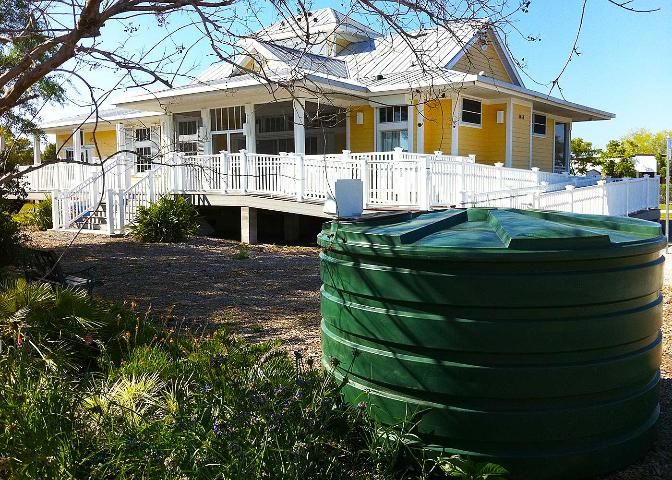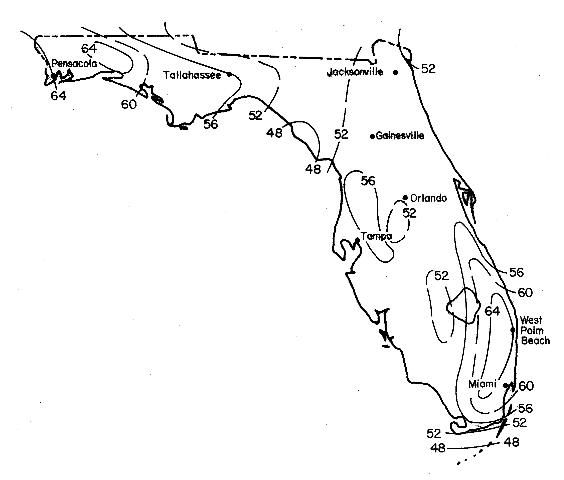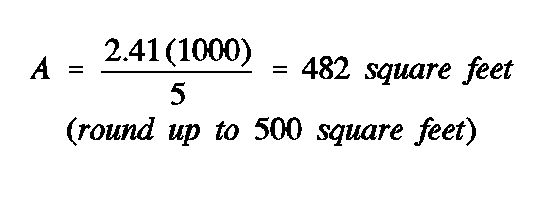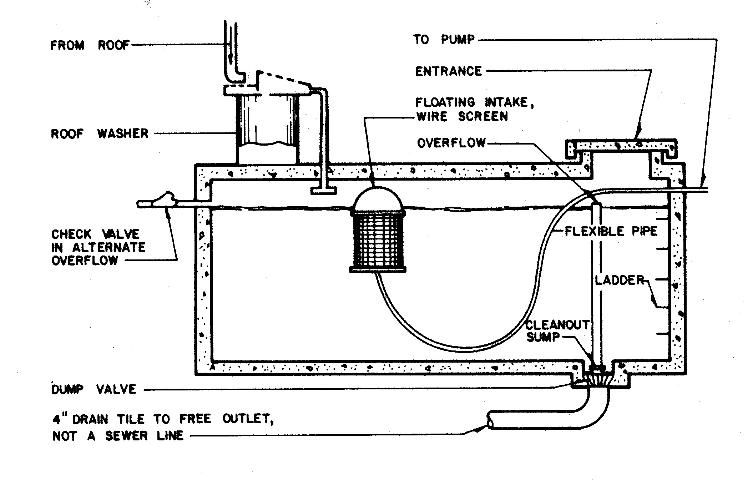Supplies of groundwater are limited in many parts of Florida. To conserve groundwater, rainwater can be used for such things as watering gardens or washing cars. Water used for such purposes, but not for human consumption, is called non-potable water.
Catch Rainwater in a Cistern
A properly constructed and operated cistern can be a source of supplemental water to provide for water needs other than human consumption. This supplemental water supply can be very useful when sources of potable water are limited or expensive.

Credit: Florida House Institute
Types of Cisterns
Cisterns are storage tanks for rainfall that has been collected from a roof or some other catchment area. Although usually located underground, cisterns may be placed at ground level or on elevated stands either outdoors or within buildings. Cisterns should be watertight, have smooth interior surfaces, enclosed lids, and be large enough to provide adequate storage. They should be fabricated from non-reactive materials such as reinforced concrete, galvanized steel, and plastic. Concrete blocks or wood are sometimes used, but these are difficult to keep watertight.
Catchment System
A catchment is an area from which runoff is collected. Galvanized steel and aluminum roofs are the best commonly used catchments. Rough surfaced materials collect dirt and debris that affect the quality of the water collected.
Gutters and downspouts should be easy to clean and inspect. Rainwater picks up dust, soot, bird droppings, leaves and other foreign materials that add objectionable organisms, color and odor to the water. Do not collect water under overhanging trees. Gutter guards and roof washers can improve the quality of the collected water.
Gutter guards made of 1/4" to 1/2" mesh hardware cloth placed over the gutters keep out leaves and other large objects. Sand, gravel or charcoal filters are sometimes used to filter water before it enters the cistern but they require frequent maintenance to prevent contamination.
Roof washers are cheaper to construct and need less maintenance than filters. A roof washer traps the first flow from the roof and channels this dirty water away from the cistern. After the first flow, the water from the rest of the rainfall flows to the cistern. The roof washer should have a capacity of about 10 gallons for each 1000 square feet of roof area. Figure 1 shows a typical roof washer consisting of a valve and shunt tap system.

Cistern Size and Catchment Area
The cistern size must be adequate to supply water needs during extended periods of low rainfall. A margin of about one-third should be allowed for water leaked from pipes, blown from the roof by wind, lost to evaporation and channeled away by the roof washer. The required catchment area depends on the amount of water needed, the cistern size, and the frequency of rainfall. The cistern and catchment area must be sized together. The catchment area must be large enough to collect enough water from rainfalls when they do occur.
The amount of water collected can be calculated using the formula demonstrated in Equation 1.

To calculate the catchment area needed to collect a required amount of water, the formula is demonstrated in Equation 2.

These formulas assume a one-third loss from leakage, spillage, and evaporation. Table 1 gives the required catchment area to collect needed volumes of water from given amounts of rainfall. For instance, to collect 1000 gallons of water from a 2 inch rain, catchment area of 1200 square feet would be required.
Figure 2 shows the average yearly rainfall for different areas of Florida. Table 2 lists monthly rainfall amounts for a number of Florida locations. Equation 1 and Equation 2 and Table 1 and/or Table 2 can be used to size cisterns and catchment areas. For instance, from Table 1, if in Key West during June 5.0 inches of rain falls, a catchment area of 500 square feet will collect 1000 gallons of water. This same value can be calculated as shown in Equation 3. Equation 2 can be used to calculate the required catchment area to collect any volume of water for any rainfall amount.


Location
Underground and surface cisterns should be located in areas that are sloped to drain surface water away from the cisterns. Cisterns are usually located near their catchments. Do not place underground or surface cisterns near sewage lines or other sources of contamination.
The site should be in firm ground to avoid settling, which can cause cracking of cistern walls. Cisterns should be located as far from trees as possible because tree roots can crack cistern walls.
Sanitation and Mosquito Control
Cisterns should be cleaned by using a stiff brush to scrub all inside surfaces. A good disinfecting solution is 1/4 cup 5.25% liquid chlorine bleach in 10 gallons of water. Flush the cistern thoroughly with clean water to remove sediment after construction, cleaning or maintenance. Do not interconnect cistern drains with waste or sewer lines to avoid backflow contamination.
Mosquito larvae thrive in stagnant water. They can be controlled by the use of commercially available pesticides such as Alfa-sid or DIPEL.
Design and Construction
An opening large enough to provide easy access of a person into the cistern should be left at the top. This opening needs to have a watertight cover with a lock to reduce the risks of contamination or accidents. An overflow pipe should also be provided. The cistern must be watertight. Inlets and outlets should be screened and valves should permit control of water flow.
Provide positive ventilation when anyone is working in a cistern. There may be hazardous gases present or insufficient oxygen. A water sealant should be applied to concrete tank surfaces.
Elevated tanks can be fabricated from concrete, metal, or plastic. The weight of these tanks is considerable. One gallon of water weighs 8.3 pounds, and each cubic foot of water weighs 62.4 pounds. Concrete weighs about 150 pounds per cubic foot. Wind loads may also be a problem on exposed elevated tanks.
Elevated tanks should be placed on structurally sound towers. They can also be designed as part of a building. When a cistern is elevated, the amount of pressure developed will depend upon the height of the water surface. About one pound of pressure is developed for each 2 1/2 feet the water surface is above the water outlet. To achieve a satisfactory rate of flow, a head of at least 20 feet of elevation is usually necessary.
Friction causes pressure losses as water flows through a pipe. There is less loss in a large pipe than in a small pipe. It is best to use at least 1 1/4 inch pipe for main supply lines.
Elevated tanks fabricated from plastics and fiberglass-reinforced plastic may have a shorter lifetime than metal or concrete tanks. If possible, tanks fabricated from synthetic materials should be located in shaded areas to reduce the damaging effects of ultraviolet radiation. Wooden cisterns are generally not satisfactory, particularly when they are used below ground, because they are difficult to keep sealed and allow pollution and ground water to enter through their cracks.
The excavation for below-ground cisterns should be large and deep enough to permit the laying of the foundation and walls. Underground tanks should be made from concrete to reduce problems of wall deterioration because of contact with the soil. Figure 3 shows the construction of a typical underground cistern. Cisterns located on the ground surface or below ground will require a pump to provide water pressure.

The walls of concrete cisterns should be four to six inches thick. A concrete mix of 5 gallons of water, 2 1/4 cubic feet of sand, and 3 cubic feet of gravel per sack of cement should be used. Use one inch diameter or smaller gravel. Make sure that the water is clean. Portland cement must be dry and free of lumps. Sand should be clean and well graded; that is, with particles of many sizes.
Maintenance
Keep gutters, gutter guards, downspouts and roof washers free of foreign materials. Keep manhole covers tight. Repair leaks promptly with sealants. Portland cement paints and epoxy resins are available to seal cracks in concrete.
Conclusion
A properly constructed and operated cistern can be a source of supplemental water to provide for water needs other than human consumption. This supplemental water supply can be very useful when sources of potable water are limited or expensive.

